| Srl | Item |
| 1 |
ID:
079729
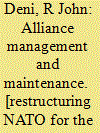

|
|
|
|
|
| Publication |
Aldershot, Ashgate Publishing Limited, 2007.
|
| Description |
122p.
|
| Standard Number |
9780754670391
|
|
|
|
|
|
|
|
|
|
|
|
Copies: C:1/I:0,R:0,Q:0
Circulation
| Accession# | Call# | Current Location | Status | Policy | Location |
| 052854 | 355.031091821/DEN 052854 | Main | On Shelf | General | |
|
|
|
|
| 2 |
ID:
053081


|
|
|
|
|
| Publication |
May-June 1996.
|
|
|
|
|
|
|
|
|
|
|
|
|
|
|
|
| 3 |
ID:
142605
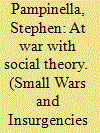

|
|
|
|
|
| Summary/Abstract |
As US counterinsurgency campaigns draw to a close, doctrine for asymmetric warfare written during the War on Terror has come under heavy criticism. While many have argued that this shift to ‘winning hearts and minds’ is evidence that the United States is taking humanitarianism and nation-building seriously, others argue that a wide gap exists between US counterinsurgency doctrine and the protection of civilians afflicted by conflict. In this article, I show that the latter is true by comparing theories of instrumental and communicative action to US doctrine for operational design, stability operations, and counterinsurgency. I argue that these texts treat the people as an object to be manipulated for the achievement of pre-determined self-interested strategic goals rather than members of a community that jointly designs operations to fulfill shared objectives. However, US doctrine does contain communicative elements that, if prioritized, would better support humanitarian and state-building objectives otherwise subordinated in the War on Terror.
|
|
|
|
|
|
|
|
|
|
|
|
|
|
|
|
| 4 |
ID:
131978
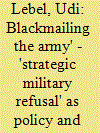

|
|
|
|
|
| Publication |
2014.
|
| Summary/Abstract |
The study shows how 'strategic military refusal' in Israel developed as a rational and institutional means to influence security policies. As opposed to the perspective that sees military refusal as a spontaneous individual act, the study illustrates how organizations operate to distribute military refusal in order to pressure decision-makers to change their military policies. This strategy has proven to be effective when the military is involved with groups that threaten it with refusal - which threatens the military's operational ability and its official and apolitical image. These include soldiers whose civilian authorities, rather than their military commanders, are perceived as an epistemic authority regarding security issues. The case study refers to the impact of strategic military refusal in Israel on security policies and the military doctrine. This was influenced by leftist groups, which, although they belonged to the parliamentary opposition, had dominant presence in the military ranks. Furthermore, the study examines the effect of the use of strategic military refusal on the model of military recruitment.
|
|
|
|
|
|
|
|
|
|
|
|
|
|
|
|
| 5 |
ID:
103684
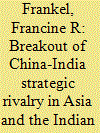

|
|
|
| 6 |
ID:
069215


|
|
|
| 7 |
ID:
117950


|
|
|
|
|
| Publication |
2012.
|
| Summary/Abstract |
Using the German Army from 1916 to 1918 as a case study, this article demonstrates a different form of military innovation than has hitherto been analysed by literature on the subject. During World War I, the German Army innovated by spreading knowledge between units rather than up and downthe chain of command. Thus, this army used 'horizontal innovation', rather than vertical innovation to change how it fought in the midst of battle. Although combat in World War I is significantly different from operations today, horizontal innovation offers armed forces a means by which to transform themselves much more rapidly than the traditionally recognised forms of military innovation.
|
|
|
|
|
|
|
|
|
|
|
|
|
|
|
|
| 8 |
ID:
064038
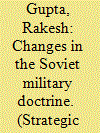

|
|
|
| 9 |
ID:
072602
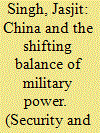

|
|
|
| 10 |
ID:
090619
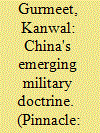

|
|
|
| 11 |
ID:
093991
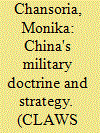

|
|
|
| 12 |
ID:
082177
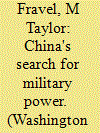

|
|
|
|
|
| Publication |
2008.
|
| Summary/Abstract |
How much military power does China ultimately desire? A close look at Chinese texts on military doctrine over the last decade reveals that Beijing's objectives for the use of military power are more certain than many policy analysts maintain
|
|
|
|
|
|
|
|
|
|
|
|
|
|
|
|
| 13 |
ID:
074002
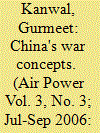

|
|
|
| 14 |
ID:
080676
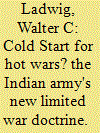

|
|
|
|
|
| Publication |
2007.
|
| Summary/Abstract |
In response to the perceived inability of the Indian military to leverage its conventional superiority to end Pakistan's "proxy war" in Kashmir, the Indian Army announced a new offensive doctrine in 2004 intended to allow it to mobilize quickly and undertake limited retaliatory attacks on its neighbor, without crossing Pakistan's nuclear threshold. This Cold Start doctrine marks a break with the fundamentally defensive military doctrines that India has employed since gaining independence in 1947. Requiring combined arms operating jointly with the Indian Air Force, Cold Start represents a significant advance in India's conventional military capabilities. Yet, despite the Indian Army's intentions, it risks provoking or escalating a crisis on the subcontinent that could breach the nuclear threshold. Recent military exercises and associated organizational changes indicate that although the Indian Army has made progress toward developing an operational Cold Start capability, particularly in the area of network-centric warfare, the doctrine remains in the experimental stage. Nevertheless, this is a development that deserves further study. As the Indian Army enhances its ability to achieve a quick military decision against Pakistan, the political pressure to employ such a strategy in a crisis will increase-with potentially catastrophic results.
|
|
|
|
|
|
|
|
|
|
|
|
|
|
|
|
| 15 |
ID:
126288
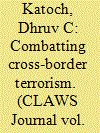

|
|
|
| 16 |
ID:
130689
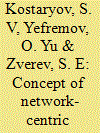

|
|
|
|
|
| Publication |
2014.
|
| Summary/Abstract |
The article discusses the U.S. commands' views on the significance of human factor in the battlefield as set out in the Joint Vision 2020 doctrine. Topics discussed include the high value on information in U.S. documents on military policy and warfare, role of high-tech weapons and information systems in military conflicts and the imperfections of technology. It also mentions the importance of effective leadership in contemporary system for educating and training of U.S. servicemen
|
|
|
|
|
|
|
|
|
|
|
|
|
|
|
|
| 17 |
ID:
190446
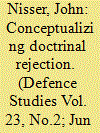

|
|
|
|
|
| Summary/Abstract |
Doctrines are considered a key component of military power, shaping the ways in which armed forces organize and operate. This study critically examines the assumption that armed forces can change their practices by writing formal doctrine. The study addresses the research problem of why some formal doctrines are implemented and others are rejected. It does so by developing and testing a novel theoretical framework on doctrinal implementation through a comparative case study on rejection of the US Army 1976 Active Defense doctrine and successful implementation of the 1982 AirLand Battle doctrine. The study shows that contrary to popular beliefs, the actual concepts within a formal doctrine do not seem crucial for whether it is implemented or rejected. Rather, cultural coherence and inclusive creation seem crucial in this regard.
|
|
|
|
|
|
|
|
|
|
|
|
|
|
|
|
| 18 |
ID:
066382
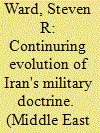

|
|
|
| 19 |
ID:
145859
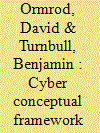

|
|
|
|
|
| Summary/Abstract |
Militaries rely on secure communications. Despite the permeation of cyber-systems throughout the operational environment, there is little readily available doctrine on cyber-warfare. Doctrine that does exist has not been coherently integrated. This paper introduces a Cyber Conceptual Framework, consisting of five questions pertinent to the future use of cyberspace. The authors enunciate a definition of cyberspace, expand on existing military doctrine to reject the conceptualisation of cyberspace as a domain, define cyber-conflict, define cyber-attack and describe the four components and five levels of a cyber-attack. This work develops a common framework from available doctrine and a lexicon for future discussion.
|
|
|
|
|
|
|
|
|
|
|
|
|
|
|
|
| 20 |
ID:
128705
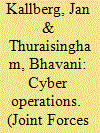

|
|
|